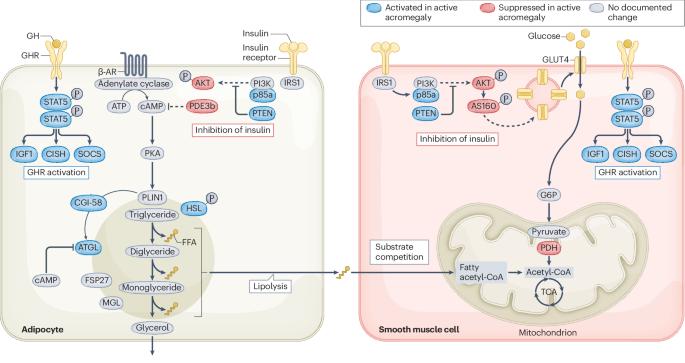肢端肥大症患者的糖尿病:病理生理学、临床挑战与管理
IF 31
1区 医学
Q1 ENDOCRINOLOGY & METABOLISM
引用次数: 0
摘要
肢端肥大症是一种罕见的内分泌疾病,由生长激素分泌过多引起,最常见的原因是垂体腺瘤。糖尿病是肢端肥大症的常见并发症,约有三分之一的患者会发生糖尿病。生长激素直接削弱胰岛素信号,刺激脂肪分解,导致外周组织对葡萄糖的吸收减少,从而增加了肢端肥大症患者患糖尿病的风险。肢端肥大症是一种独特的人体模型,其胰岛素抵抗与肥胖无关,但却与瘦削表型和体内脂肪组织质量减少有关。肢端肥大症患者的糖尿病与心血管疾病发病和死亡风险增加有关。因此,对这些患者采取预防措施和优化糖尿病治疗至关重要。然而,由于这方面的研究有限,目前还缺乏继发于肢端肥大症的糖尿病管理的具体建议。本综述探讨了肢端肥大症糖尿病的内在机制及其对发病率和死亡率的影响。我们还讨论了适合肢端肥大症患者的糖尿病治疗方法。加深对这些问题的理解将有助于更好地治疗肢端肥大症及其相关代谢并发症。本文章由计算机程序翻译,如有差异,请以英文原文为准。


Diabetes mellitus in patients with acromegaly: pathophysiology, clinical challenges and management
Acromegaly is a rare endocrine disease caused by hypersecretion of growth hormone, most commonly arising due to a pituitary adenoma. Diabetes mellitus is a common complication of acromegaly, occurring in approximately one-third of patients. The risk of diabetes mellitus in acromegaly is driven by increased exposure to growth hormone, which directly attenuates insulin signalling and stimulates lipolysis, leading to decreased glucose uptake in peripheral tissues. Acromegaly is a unique human model, where insulin resistance occurs independently of obesity and is paradoxically associated with a lean phenotype and reduced body adipose tissue mass. Diabetes mellitus in patients with acromegaly is associated with an increased risk of cardiovascular morbidity and mortality. Therefore, preventive measures and optimized treatment of diabetes mellitus are essential in these patients. However, specific recommendations for the management of diabetes mellitus secondary to acromegaly are lacking due to limited research on this subject. This Review explores the underlying mechanisms for diabetes mellitus in acromegaly and its effect on morbidity and mortality. We also discuss treatment modalities for diabetes mellitus that are suited for patients with acromegaly. Improved understanding of these issues will lead to better management of acromegaly and its associated metabolic complications. Patients with acromegaly are commonly affected by diabetes mellitus, which occurs as a complication of growth hormone hypersecretion. This Review discusses the pathophysiology of diabetes mellitus in acromegaly and explores management options in these patients.
求助全文
通过发布文献求助,成功后即可免费获取论文全文。
去求助
来源期刊

Nature Reviews Endocrinology
医学-内分泌学与代谢
CiteScore
42.00
自引率
0.70%
发文量
158
审稿时长
6-12 weeks
期刊介绍:
Nature Reviews Endocrinology aspires to be the foremost platform for reviews and commentaries catering to the scientific communities it serves. The journal aims to publish articles characterized by authority, accessibility, and clarity, enhanced with easily understandable figures, tables, and other visual aids. The goal is to offer an unparalleled service to authors, referees, and readers, striving to maximize the usefulness and impact of each article. Nature Reviews Endocrinology publishes Research Highlights, Comments, News & Views, Reviews, Consensus Statements, and Perspectives relevant to researchers and clinicians in the fields of endocrinology and metabolism. Its broad scope ensures that the work it publishes reaches the widest possible audience.
 求助内容:
求助内容: 应助结果提醒方式:
应助结果提醒方式:


